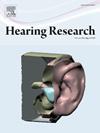通过同步脑激活模式预测儿童人工耳蜗植入结果的可变性:来自近红外光谱的见解
IF 2.5
2区 医学
Q1 AUDIOLOGY & SPEECH-LANGUAGE PATHOLOGY
引用次数: 0
摘要
目的利用功能近红外光谱(fNIRS)研究了与正常听力(NH)对照相比,儿童人工耳蜗(CI)使用者皮质激活与听觉表现之间的关系。目的是确定CI结果的神经预测因子,并研究植入后皮质可塑性。15名儿童CI使用者和17名NH对照者在进行fNIRS记录时同时执行非言语辨别和句子识别任务。研究人员评估了双侧颞叶、额叶和顶叶区域的皮质激活情况,并通过相关和回归分析检验了皮质活动是否能预测听觉表现的变异性。结果sci使用者在非言语识别方面的表现与NH对照组相似(92.6±8.5%比91.7±7.8%),但句子识别准确率较低(76.9±14.1%比96.1±3.1%,p <;0.05)。分层回归显示,CI组的双通道交互作用解释了68%的非言语歧视方差(调整R²= 0.68,p = 0.002)和61%的句子识别方差(调整R²= 0.61,p = 0.001)。右侧颞中回激活与非言语准确性呈正相关(β = 1.20, p = 0.001),左侧颞上回激活与非言语准确性呈负相关(β = -0.83, p = 0.007)。左侧额下回激活与句子识别呈负相关(β = -0.94, p <;而左侧下顶叶激活呈正相关(β = 0.57, p = 0.007)。相比之下,NH参与者依赖于更灵活和集成的神经处理网络,并且没有发现显著的皮层预测因子,这表明更少的局部化,更分散的激活模式。结论这些发现为CI使用者的神经可塑性和代偿机制提供了新的见解,强调了皮层相互作用在非言语和句子水平加工中的重要作用。层次模型的强大预测能力突出了fNIRS在植入后皮质评估中的潜力。考虑到横断面设计和样本量的限制,需要进行纵向研究来验证这些发现,并进一步完善听觉康复策略,以提高儿童CI使用者的语言感知结果。本文章由计算机程序翻译,如有差异,请以英文原文为准。

Predicting variability in pediatric cochlear implant outcomes through synchronous brain activation patterns: Insights from fNIRS
Objectives
This study examined the relationship between cortical activation and auditory performance in pediatric cochlear implant (CI) users compared to normal-hearing (NH) controls using functional near-infrared spectroscopy (fNIRS). The aim was to identify neural predictors of CI outcome and to investigate post-implantation cortical plasticity.
Design
Eighteen pediatric CI users and 17 NH controls performed simultaneously non-speech discrimination and sentence recognition tasks while undergoing fNIRS recording. Cortical activation was assessed in bilateral temporal, frontal, and parietal regions, and correlation and regression analyses examined whether cortical activity predicted auditory performance variability.
Results
CI users performed similarly to NH controls on non-speech discrimination (92.6 ± 8.5 % vs. 91.7 ± 7.8 %), but had lower sentence recognition accuracy (76.9 ± 14.1 % vs. 96.1 ± 3.1 %, p < 0.05). Hierarchical regression showed that dual-channel interactions in the CI group explained 68 % of the variance in non-speech discrimination (adjusted R² = 0.68, p = 0.002) and 61 % in sentence recognition (adjusted R² = 0.61, p = 0.001). Right middle temporal gyrus activation was positively correlated with non-speech accuracy (β = 1.20, p = 0.001), while left superior temporal gyrus activation was negatively associated (β = -0.83, p = 0.007). Left inferior frontal gyrus activation was negatively correlated with sentence recognition (β = -0.94, p < 0.001), while left inferior parietal lobule activation was positively associated (β = 0.57, p = 0.007). In contrast, NH participants relied on a more flexible and integrated neural processing network, and no significant cortical predictors were identified, suggesting a less localized, more distributed activation pattern.
Conclusions
These findings provide novel insights into neural plasticity and compensatory mechanisms in CI users, emphasizing the crucial role of cortical interactions in non-speech and sentence-level processing. The strong predictive power of hierarchical models highlights the potential of fNIRS in post-implantation cortical assessment. Given the cross-sectional design and sample size limitations, longitudinal research is needed to validate these findings and to further refine auditory rehabilitation strategies to enhance speech perception outcomes in pediatric CI users.
求助全文
通过发布文献求助,成功后即可免费获取论文全文。
去求助
来源期刊

Hearing Research
医学-耳鼻喉科学
CiteScore
5.30
自引率
14.30%
发文量
163
审稿时长
75 days
期刊介绍:
The aim of the journal is to provide a forum for papers concerned with basic peripheral and central auditory mechanisms. Emphasis is on experimental and clinical studies, but theoretical and methodological papers will also be considered. The journal publishes original research papers, review and mini- review articles, rapid communications, method/protocol and perspective articles.
Papers submitted should deal with auditory anatomy, physiology, psychophysics, imaging, modeling and behavioural studies in animals and humans, as well as hearing aids and cochlear implants. Papers dealing with the vestibular system are also considered for publication. Papers on comparative aspects of hearing and on effects of drugs and environmental contaminants on hearing function will also be considered. Clinical papers will be accepted when they contribute to the understanding of normal and pathological hearing functions.
 求助内容:
求助内容: 应助结果提醒方式:
应助结果提醒方式:


